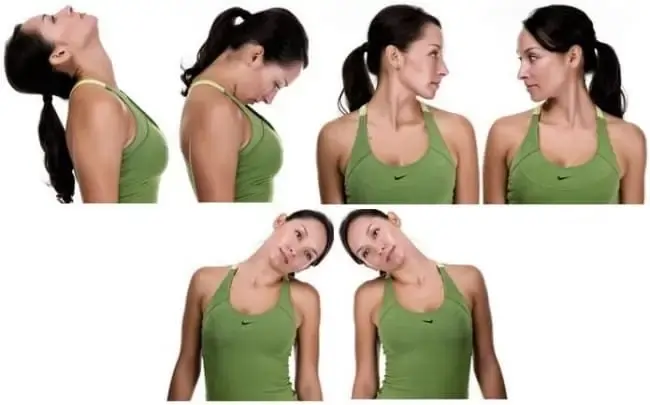Active Neck Exercise: Health Benefits, How to do?
What is active neck exercise?
Active neck exercise is the best exercise you can easily do at home .. This is exercise helps you to improve neck posture and maintain range of motion of neck.
This is a most effective exercise for neck pain, this exercise helps to strengthen your neck muscles.
- This exercise you have to perform on your own.
- Active neck exercise includes all neck movements like flexion, extension, side flexion,rotation.
- For this exercise, you will not need any type of equipment.
- This exercise helps you to prevent neck pain,cervical radiculopathy and many more posture related complains.
- In today’s scenario, many people have neck complain due to prolonged sitting, altered posture, hazardous use of cell phones, and improper sleeping pattern.
- For preventing this neck pain you should do neck exercise in your daily routine.
Which muscle is used in neck movements?
Neck flexors : longus capitus and longus colli muscles
Neck extensors: semispinalis cervicis, Sternocleidomastoid
Neck rotators: Sternocleidomastoid
Neck side flexors: scalene muscles

Causes of neck pain:
- More usage of computer and cellphone
- Continuous reading for 3 to 4 hours
- Driving or sitting for prolonged periods
- More cycling
- Walking, especially on uneven terrain
- Uneven sleeping position
- Sewing, sketching or writing for a prolonged time
- Carrying a heavy bag on your shoulder
- Sports activity which used one side of the body
- Continuous movements of the upper body
Health Benefits of doing active neck exercise:
- Help to Improve your posture
- Helps to avoid slouching or letting your head fall forward
- Keep your joint Healthy,
- Keep your muscles healthy
- Healthy bones which help you to maintain a normal range of motion.
- Causes of pain, tightness, and decreased mobility
- Help to build muscle strength, and restore mobility.
- Perform these exercises in short sessions throughout the day, as part of your fitness routine, or to warm up or cool down.
- To prevent recurring pain, continue to do daily stretches even after you start to feel better.
- Prevent cervical radiculopathy
Different types of neck movements explain below:

Neck flexion:
How to do?
- Neck flexion is the motion of lower down your chin towards your chest.
- A normal range of motion of neck flexion is 40 to 80 degrees, which is measured by a goniometer.
- For this exercise, you have to sit straight in a chair.
- Rest both arms by your side and stabilize your spine by engaging your core muscles.
- Take your shoulder blades back and down.
- Then Slowly draw your chin in toward your chest.
- Hold this position for 25–30 seconds.
- Do 2–3 repetitions.
Neck extension:
How to do?
- The main aim of these exercises is to decrease the intensity and severity of symptoms. These will stretch the neck and help to relieve neck tension and pain, making them the perfect counterbalance to activities that require you to look down repeatedly.
- For this exercise, you have to sit straight in a chair. your arms rest on the armrest.
- Then slowly bend your neck backside and you have to look up towards ceilings.
- Hold this position for 25–30 seconds.
- Do 2–3 repetitions.
Neck side flexion:
How to do?
- For this exercise, you have to sit straight in a chair or stand.
- Rest both arms by your side and stabilize your spine by engaging your core muscles.
- Take your shoulder blades back and down.
- Now slowly move your neck towards your right shoulder keep your shoulder steady try to touch your ear to shoulder.
- Hold this position for 25–30 seconds.
- Do 2–3 repetitions.
Neck rotation:
How to do?
- This exercise will help you to turn your neck behind make it easier to check for traffic when driving and turn quickly to any side when playing sports.
- For this exercise, you have to sit straight in a chair or stand.
- Rest both arms by your side and stabilize your spine by engaging your core muscles.
- From this, You will feel stretched by the side of your neck.
- Then Gently rotate your neck to the right and look over your shoulder joint, not to touch ear only move neck towards shoulder.
- Hold this position for 5–10 seconds.
- Do this on another side.
- Do 2–4 repetitions on both sides.
- Apply gentle pressure to your chin for getting more rotation.
Neck retraction
How to do?
- This exercise will help to loosen up tight muscles, relieves pain, and decrease spinal pressure. try to keep your eyes facing forward throughout the movement. this exercise mostly advisable for chin poke out posture. this exercise is also known as chin tuck-in.
- For this exercise, you have to sit straight in a chair or stand.
- Rest both arms by your side your and stabilize your spine by engaging your core muscles.
- Then take one hand above spread fingers over the chin to push your head far backward as you can do. by this you will feel stretch in the backside of your neck.
- Place your fingers on your chin to push your head as far backward as possible.
- Feel the stretch in the back of your neck.
- Hold this position for 25–30 seconds.
- Do 2–3 repetitions.
Dos and Don’t s for your neck
Do’s of Neck Pain
- Drink plenty of water.
- Set your laptop or computer exactly eye level.
- Take the proper height pillow to maintain proper posture.
- Check your trunk alignment.
- If you are a computer operator then do exercise in between your work session.
- Use a backpack in of a shoulder bag.
- Follow a healthy diet.
- Stay hydrated.
- Don’t smoke.
- Neck muscle tightness may be decreased by using a heating pad or ice pack before and after stretching apply.
- Use a pillow that allows your head and neck to rest in a straight position.
Do not do of Neck Pain
- Carry your bag over one shoulder
- Not to Sleep on your tummy
- Gaze down at your mobile phone
- Try to Sleep on an old, worn-out mattress
- Avoid prolonged sitting
When do you not do Active neck exercise?
- If you are suffering from pain during normal activities and your symptoms go away from the center of your neck to your shoulder and pain is accompanied by numbness, tingling, or weakness.
- If you have recovered from any injuries,
- If pain worsens by doing the exercises,
- If you feel Severe pain that does not go away by exercise then stop doing exercise.






